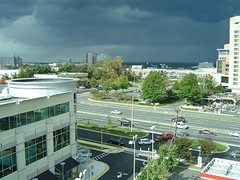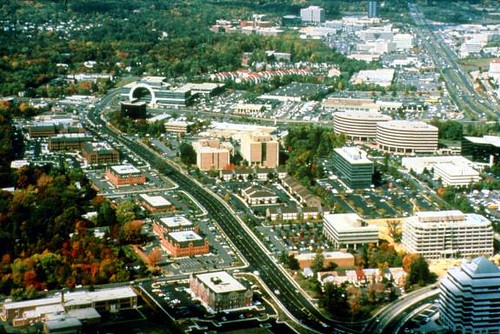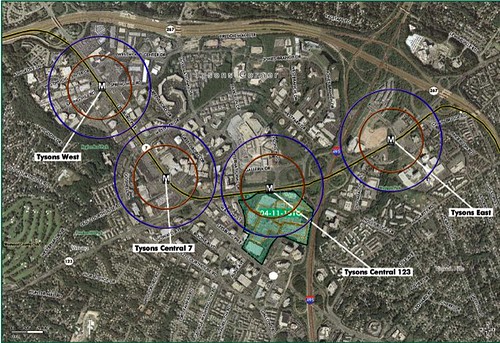Edge city makeover: Can Tysons Corner go from sow’s ear to silk purse?

Posted May 29, 2008 at 10:40PM
The Washington Post has a story today on page one (above the fold, for you media junkies, and you know who you are) about plans to make a real city out of the mess now known as Tysons Corner in Fairfax County, Virginia.
Tysons (I keep thinking there should be an apostrophe there, but few writers use it) was tagged in Joel Garreau’s iconic 1991 book, Edge City, as prototypical of the kinds of suburban shopping and job centers that were springing up around interstates and beltways near America’s larger traditional cities. Garreau called Tysons then “the largest urban agglomeration between Washington and Atlanta,” and I doubt if the distinction has been challenged since.
It’s an environmentalist’s, and a smart growth advocate’s, worst nightmare. Utterly unreachable except by car and utterly unwalkable unless one has parked the car and arrived safely inside a shopping mall, Tysons is notorious for having the worst traffic congestion in the greater Washington metro area, and that’s saying something. The place has no coherence, no center, no logic, no public green space, and obviously no planning. Although the basic point of Garreau’s book was that we had better get used to this sort of place, here’s a bit more of what he had to say:
“For my sins I once spent a fair chunk of a Christmas season in Tysons Corner, Virginia, stopping people as they hurried about their holiday tasks, asking them what they thought of their brave new world. The words I recorded were searing. They described the area as plastic, a hodgepodge, Disneyland (used as a pejorative), and sterile. They said it lacked livability, civilization, community, neighborhood, and even a soul.”
They won’t get an argument from me. Note the images above to get a glimpse of the area. My guess is that it looks familiar, no matter where you are in the US, since this is now what much of America looks like. Tysons meets all of Garreau’s criteria for an “edge city” in abundance:
- Five million square feet or more of leasable office space
- 600,000 square feet or more of leasable retail space
- More jobs than bedrooms
- Perceived by the public as one place (even though it may lack jurisdictional recognition)
- Nothing like a “city” as we have traditionally thought of the term
So, can the area be remade into something more humane, more functional, more environmentally sustainable? Can we have a compact density, walkability and transportation choices, many more homes within walking distance of jobs and shopping, more public spaces, more sense of community? It will be a challenge.
At least we are likely to have Metro, the region’s rail public transportation system, which has plans to extend its lines through Tysons out to Dulles Airport. The federal and state authorities continue to bicker over the plans and financing, but I believe it will happen, probably above ground. (It would be much more amenable to all the things we seek if placed below ground, but I’ll take it.) The proposed new Metro stations through Tysons are indicated below:
The local Coalition for Smarter Growth has been working with a task force to refine the development plans. I have to say that I hope the soulless visions posted in a photo slide show and video on the Post’s web site today represent an unimaginative developer's vision and not that of the task force. Surely we can do better than that. (Here is an interesting discussion of how the area might be redesigned.)
As the Post’s article points out,
"Getting it right has been a 3 1/2 -year undertaking for the Tysons Land Use Task Force, an unwieldy collection of neighborhood representatives, business leaders and developers that is preparing to release a 200-page recommendation on how to remake Tysons. Appointed in 2004 by the Fairfax County Board of Supervisors, the task force has studied every aspect of redeveloping Tysons Corner: parking management, traffic patterns, a 'circulator' bus line, affordable housing, sewers, storm water.
"The task is daunting. It's not easy to imagine a future city while idling at one of the interminable left-turn signals, or spilling off the eight-lane Capital Beltway, or sliding behind the wheel for a lunch date two blocks away because walking is out of the question. Tysons is Fairfax's de facto downtown, but it is a place with more parking (40 million square feet) than offices (28 million square feet); more workers who drive in (120,000) than residents who sleep in (17,000); highways that divide (Route 7, Route 123, the Dulles Toll Road, the Capital Beltway); and too few ways in and out . . .
"Powerful constituencies are lined up against them. Tysons covers fewer than 2,000 acres and is surrounded by well-established residential neighborhoods. These communities, primarily with McLean, Vienna and Falls Church addresses, are anxious about the impact of a major development boom in Tysons."
I don’t blame the NIMBYs for being fearful. The area’s development history gives plenty of reasons to scare the hell out of most anyone. This needs to be done thoughtfully. But there’s no question that it needs to be done, and I hope the region’s environmental groups will be there to help make it happen. Just as Tysons has been the national model for how to screw things up, its makeover will be a national model, too.


